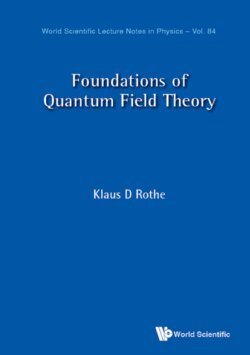Читать книгу Foundations of Quantum Field Theory - Klaus D Rothe - Страница 8
На сайте Литреса книга снята с продажи.
ОглавлениеContents
Preface
1The Principles of Quantum Physics
1.1Principles shared by QM and QFT
1.2Principles of NRQM not shared by QFT
2Lorentz Group and Hilbert Space
2.1Defining properties of Lorentz transformations
2.2Classification of Lorentz transformations
2.3Lie algebra of the Lorentz group
2.4Finite irreducible representation of
2.5Transformation properties of massive 1-particle states
2.6Transformation properties of zero-mass 1-particle states
3Search for a Relativistic Wave Equation
3.1A relativistic Schrödinger equation
3.2Difficulties with the wave equation
3.3The Klein–Gordon equation
3.4KG equation in the presence of an electromagnetic field
4The Dirac Equation
4.1Dirac spinors in the Dirac and Weyl representations
4.2Properties of the Dirac spinors
4.3Properties of the γ-matrices
4.4Zero-mass, spin = fields
4.5Majorana fermions
5The Free Maxwell Field
5.1The radiation field in the Lorentz gauge
5.2The radiation field in the Coulomb gauge
6Quantum Mechanics of Dirac Particles
6.1Probability interpretation
6.2Non-relativistic limit
6.3Negative-energy solutions and localization
6.4The Klein Paradox
6.5Foldy–Wouthuysen Transformation
7Second Quantization
7.1Fock-space representation of fields
7.2Commutation relations
7.3P, C, T from equations of motion
7.4P, C, T in second quantization
8Canonical Quantization
8.1Lagrangian formulation and Euler–Lagrange equations
8.2Canonical quantization: unconstrained systems
8.3Canonical quantization: constrained systems
8.4QED as a constrained system
9Global Symmetries and Conservation Laws
9.1Noether’s Theorem
9.2Internal symmetries
9.3Translational invariance
9.4Lorentz transformations
10The Scattering Matrix
10.1The S-matrix and T-matrix
10.2Differential cross-section
10.3LSZ reduction formula
11Perturbation Theory
11.1Interaction picture and U-matrix
11.2Interaction picture representation of Green functions
11.3Wick theorems
11.42-point functions
11.5Feynman Diagrams for QED
11.6Furry’s theorem
11.7Going over to momentum space
11.8Momentum space Feynman rules for QED
11.9Moeller scattering
11.10The Moeller differential cross-section
11.11Compton scattering
12Parametric Representation of a General Diagram
12.1Cutting rules for a general diagram
12.2An alternative approach to cutting rules
12.34-point function in the ladder approximation
13Functional Methods
13.1The Generating Functional
13.2Schwinger’s Construction of
13.3Feynman Path-Integral
13.4Path-integral representation of correlators in QM
13.5Feynman path-integral representation in QFT
13.6Path-Integral for Grassman-valued fields
13.7Extension to Field Theory
13.8Mathews–Salam representation of QED generating functional
13.9Faddeev–Popov quantization and a-gauges
14Dyson–Schwinger Equation
14.1Classification of Feynman Diagrams
14.2Basic building blocks of QED
14.3Dyson–Schwinger Equations
15Regularization of Feynman Diagrams
15.1Pauli–Villars and dimensional regularization
15.1.1Electron self-energy
15.1.2Photon vacuum polarization
15.1.3The vertex function
16Renormalization
16.1The principles of renormalization
16.2Renormalizability of QED
16.2.1Fermion 2-point function
16.2.2Photon 2-point function
16.2.3Vertex function
16.3Ward–Takahashi Identity and overlapping divergences
16.41-loop renormalization in QED
16.5Composite operators and Wilson expansion
16.6Criteria for renormalizability
16.7Taylor subtraction
16.8Bogoliubov’s recursion formula
16.9Overlapping divergences
16.10Dispersion relations: a brief view
17Broken Scale Invariance and Callan–Symanzik Equation
17.1Scale transformations
17.2Unrenormalized Ward identities of broken scale invariance
17.3Broken scale invariance and renormalized Ward identities
17.4Weinberg’s Theorem
17.5Solution of CS equation in the deep euclidean region
17.6Asymptotic behaviour of r and zeros of the β-function
17.7Perturbative calculation of β(g) and γ(g) in ϕ4 theory
17.8QED β-function and anomalous dimension
17.9QED β-function and leading log summation
17.10Infrared fix point of QED and screening of charge
18Renormalization Group
18.1The Renormalization Group equation
18.2Asymptotic solution of RG equation
19Spontaneous Symmetry Breaking
19.1The basic idea
19.2More about spontaneous symmetry breaking
19.3The Goldstone Theorem
19.4Realization of Goldstone Theorem in QFT
20Effective Potentials
20.1Generating functional of proper functions
20.2The effective potential
20.3The 1-loop effective potential of ϕ4-theory
20.4WKB approach to the effective potential
20.5The effective potential and SSB
Index
